Sandpipers
There are many types of shorebirds along Kootenay Lake. There are sandpipers, plovers, stilts, avocets, yellowlegs, curlews, godwits and phalaropes, and a variety of species within these categories. (Excluded from this category are the web-footed birds such as ducks). I get the impression that one could spend one’s life identifying and understanding shorebirds, such is the variety.
Shorebirds are fairly small, have long legs and long beaks, and wander along the edge of the Lake, sometimes in the water, but usually on the wet sand. They bob and poke at the surface and capture invertebrates which they pick out of the sand or mud. Different lengths of bills enable different species to feed to different depths without direct competition for food. Many of these birds have sensitive nerve endings at the end of their bills which enable them to detect prey items hidden below the surface.
Probably the most common shorebird along the Lake is the Spotted Sandpiper. This bird is unusual. The female arrives at the Lake first to choose a nesting site. Then she mates with a number of males and produces a clutch where various eggs are from different males (she is polyandrous). One male then provides most of the care for that brood. But, the female can produce up to five clutches a season.
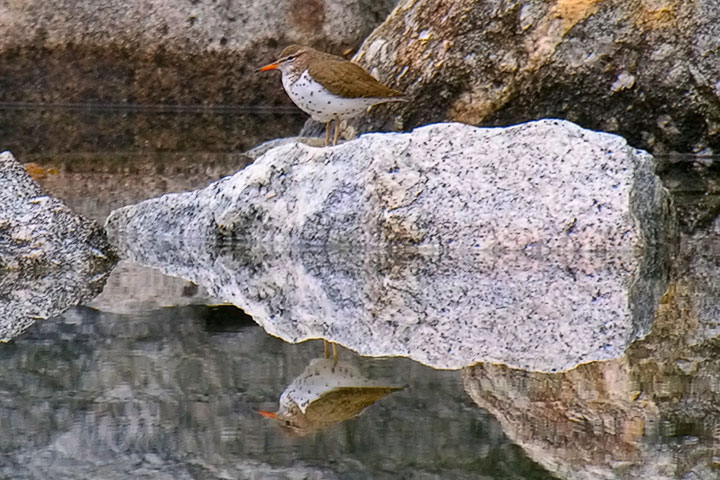 The Spotted Sandpiper (and its reflection) scours for insects and small invertebrates among the shoreline rocks. This bird looks pregnant. The spots are only present during breeding season.
The Spotted Sandpiper (and its reflection) scours for insects and small invertebrates among the shoreline rocks. This bird looks pregnant. The spots are only present during breeding season.
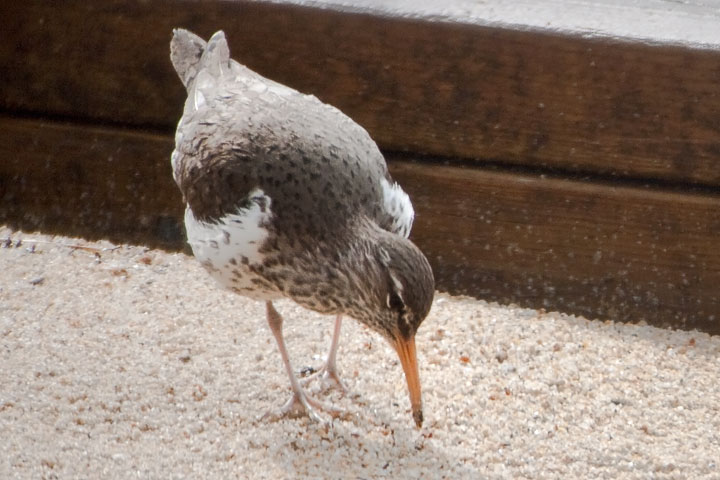 The Spotted Sandpiper spends most of its time on the shore probing the sand for delectables.
The Spotted Sandpiper spends most of its time on the shore probing the sand for delectables.
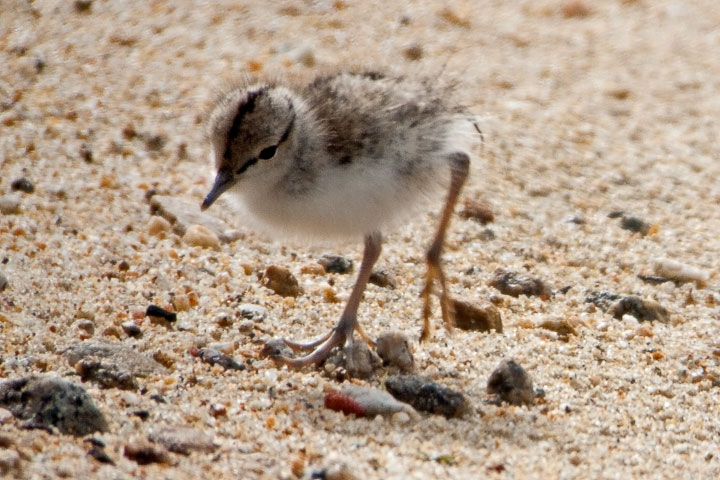 The Spotted Sandpiper chick has to feed itself.
The Spotted Sandpiper chick has to feed itself.
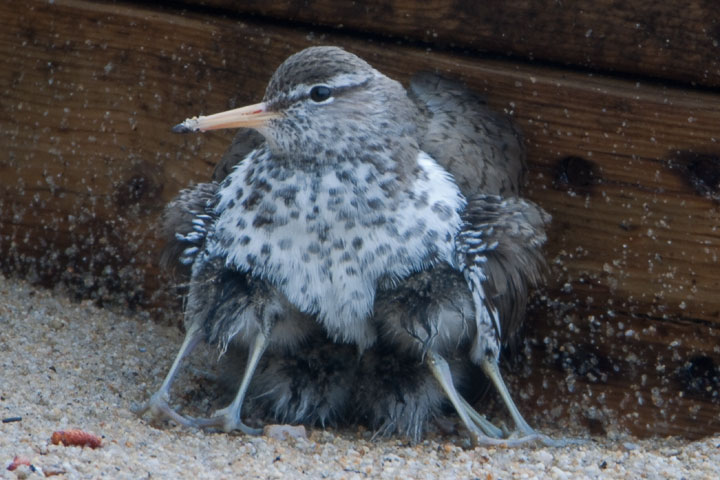 Looking as if it has four legs, this male Spotted Sandpiper broods three chicks. It is keeping them warm by sandwiching them against the boards at the end of a dock. Not that one can tell how many chicks there are from the picture, but soon they separated. Seen below are two of the chicks.
Looking as if it has four legs, this male Spotted Sandpiper broods three chicks. It is keeping them warm by sandwiching them against the boards at the end of a dock. Not that one can tell how many chicks there are from the picture, but soon they separated. Seen below are two of the chicks.
 Two Spotted Sandpiper chicks.
Two Spotted Sandpiper chicks.
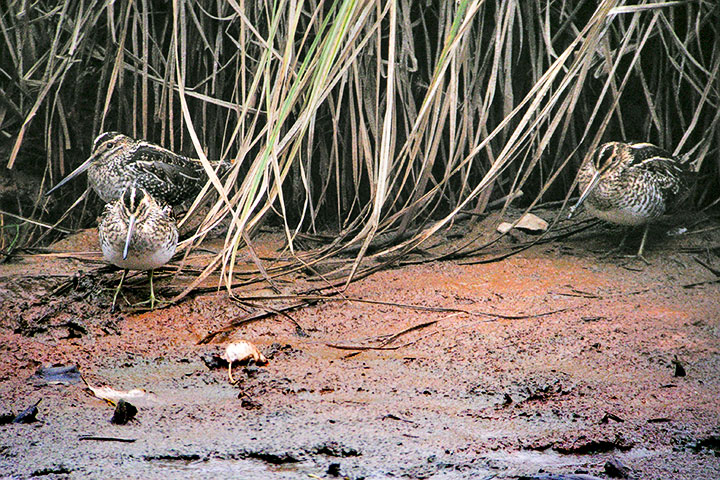 The Wilson’s Snipe is the common snipe of North America and the only snipe to be encountered in the vicinity of the Lake. A snipe is a short–legged, long–beaked sandpiper. Not all that rare, its secretiveness makes it difficult to find. Rather than patrolling the beaches as does, say, the Spotted Sandpiper, it conceals itself in or close to ground vegetation.
The Wilson’s Snipe is the common snipe of North America and the only snipe to be encountered in the vicinity of the Lake. A snipe is a short–legged, long–beaked sandpiper. Not all that rare, its secretiveness makes it difficult to find. Rather than patrolling the beaches as does, say, the Spotted Sandpiper, it conceals itself in or close to ground vegetation.
 The Snipe prefers the muddy margin of streams where it uses its long beak to probe for insects, earthworms and plant material. The male is smaller than the female and so, of these two, it is likely the male in the front and the female in the back.
The Snipe prefers the muddy margin of streams where it uses its long beak to probe for insects, earthworms and plant material. The male is smaller than the female and so, of these two, it is likely the male in the front and the female in the back.
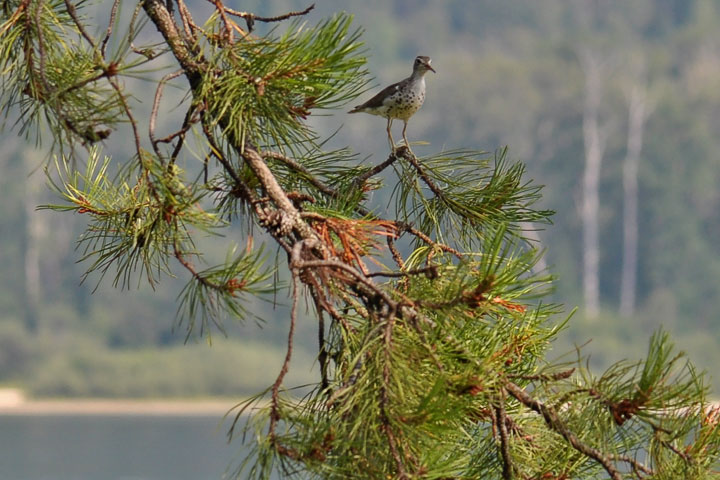 The Spotted Sandpiper looks distinctly odd perching in a tree. Normally, sandpipers are only seen walking along the shore. But, this one saw a cat, flew into a lodgepole pine, and peeped vigourously. Presumably, it was attempting to draw attention away from its chicks. If so, the ploy was successful: the cat sat fixated on the parent.
The Spotted Sandpiper looks distinctly odd perching in a tree. Normally, sandpipers are only seen walking along the shore. But, this one saw a cat, flew into a lodgepole pine, and peeped vigourously. Presumably, it was attempting to draw attention away from its chicks. If so, the ploy was successful: the cat sat fixated on the parent.
Information from Wikipedia: Spotted Sandpiper, Wilson’s Snipe.
![]()